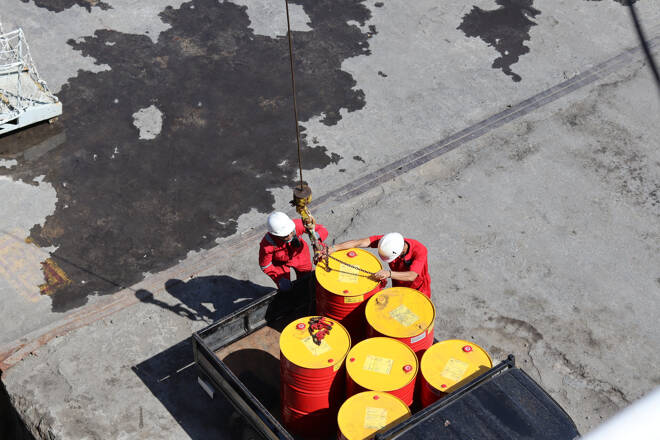Advertisement
Advertisement
Oil Price Fundamental Daily Forecast – Higher on Weaker US Dollar Ahead of EIA Report
By:
Crude oil traders will be eyeing the U.S. Dollar and the EIA inventories report for direction on Wednesday.
U.S. West Texas Intermediate and international-benchmark Brent crude oil futures continue to grind higher for a second session on Wednesday on demand hopes fueled by China’s recovery and a weaker U.S. Dollar.
Meanwhile, a pipeline shutdown in Turkey caused by this week’s earthquake is also giving the market a boost ahead of today’s U.S. government’s inventory report.
At 09:18 GMT, April WTI crude oil futures are trading $78.54, up $1.15 or +1.49% and April Brent crude oil is at $84.75, up $1.06 or +1.27%. On Tuesday, the United States Oil Fund ETF (USO) settled at $67.76, up $2.26 or +3.45%.
Powell’s Less-Hawkish Tone Weakens Dollar
WTI and Brent are garnering support after Federal Reserve Chair Jerome Powell delivered a less-hawkish message on interest rates than traders had anticipated Tuesday afternoon.
With less aggressive interest rate hikes in the United States, the market is hoping the world’s biggest economy and oil consumer can dodge a sharp slowdown in economic activity or even a recession and avoid a slump in oil demand.
The dollar index is down on Wednesday, extending losses fueled by Powell’s remarks on Tuesday. A weaker greenback tends to drive up foreign demand for dollar-denominated WTI crude oil.
China’s Oil Demand and Increased Producer Input
Oil producers may have to reconsider their output policies following a demand recovery in China, the world’s second-largest oil consumer, the International Energy Agency’s Executive Director Fatih Birol said on Sunday.
Demand in China, the world’s largest crude importer and No. 2 buyer of liquefied natural gas, has become the biggest uncertain factor in global oil and gas markets in 2023 as investors bet on the speed of its recovery after Beijing lifted COVID restrictions.
“We expect about half of the growth in global oil demand this year will come from China,” Birol told Reuters on the sidelines of the India Energy Week conference.
“If demand goes up very strongly, if the Chinese economy rebounds, then there will be a need, in my view, for the OPEC+ countries to look at their (output) policies,” Birol said.
US Crude Output to Rise in 2023, While Demand to Stay Flat – EIA
U.S. crude production will rise in 2023 even as demand flattens, the U.S. Energy Information Administration (EIA) said on Tuesday in its Short Term Energy Outlook.
EIA’s latest forecast calls for crude oil production to rise by 590,000 barrels per day, to 12.49 million barrels per day (bpd) in 2023, and by another 160,000 barrels to 12.65 million bpd next year.
Daily Forecast – Focus on EIA Stockpiles and US Dollar
Crude oil traders will be eyeing the U.S. Dollar and the EIA inventories report for direction on Wednesday. A weaker U.S. Dollar will be bullish for crude oil along with a drop in EIA inventories.
Late Tuesday, weekly inventory data from the American Petroleum Institute (API) showed crude stocks fell by about 2.2 million barrels in the week ended Feb. 3, according to market sources. That defied expectations from nine analysts polled by Reuters, who had estimated crude stocks grew by 2.5 million barrels.
However, gasoline and distillate inventories rose more than expected, with gasoline stocks up by about 5.3 million barrels and distillate stocks, which include diesel and heating oil, up by about 1.1 million barrels.
Traders will be looking at the EIA report, due at 15:30 GMT, to confirm the API’s decline in crude stocks.
For a look at all of today’s economic events, check out our economic calendar.
About the Author
James Hyerczykauthor
James Hyerczyk is a U.S. based seasoned technical analyst and educator with over 40 years of experience in market analysis and trading, specializing in chart patterns and price movement. He is the author of two books on technical analysis and has a background in both futures and stock markets.
Did you find this article useful?
Latest news and analysis
Advertisement
